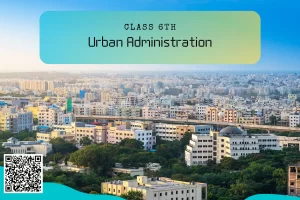
NCERT Solutions for Class 6 Social Science Civics Chapter 8 – “Urban Livelihoods”

People in urban areas are either self-employed or work for someone. They earn their living in various ways. It is also seen that various people travel from rural to urban areas in search of work and a better life. A large portion of these workers are self-employed and work on streets selling goods, repairing items, or providing a variety of services. Chapter 8 of CBSE Class 6 Civics talks about the livelihoods of people living in urban areas, the kind of jobs that they have, the positives of permanent jobs, and the negatives associated with non-permanent jobs.
1. Read and discuss the following description of the living conditions of workers who come to the labour chowk. Most workers that we find at the Labour Chowk cannot afford permanent accommodation, so they sleep on pavements near the chowk, or they pay Rs. 6 a night for a bed at a nearby night shelter run by the Municipal Corporation. To compensate for the lack of security, local tea and cigarette shops function as banks, moneylenders and safety lockers, all rolled into one. Most workers leave their tools at these shops for the night for safekeeping and pass on any extra money to them. The shopkeepers keep the money safe and also offer loans to labourers in need.
Source: Aman Sethi, Hindu On-line
NCERT Solutions for Class 6 Social Science Civics Chapter 9 – “Urban Livelihoods”
Solution 1:
- Their living conditions are very poor – without any access to basic facilities like sanitation and drinking water.
- Due to the lack of basic facilities, they will be prone to many diseases.
- As they live in poverty, they cannot access medical facilities.
- They do not have permanent jobs.
- They don’t have access to education and will continue living in poverty.
2. Complete the following table and discuss how their work is different:
| Name | Place of Work | Earnings | Security of Work | Benefits Received | Work on Their Own or Employed |
| Bachchu Manjhi | Rs. 100 a day | ||||
| Harpreet, Vandana | Work on their own | ||||
| Nirmala | No security | ||||
| Sudha | Company | Rs. 30,000 p.m. |
Solution 2:
| Name | Place of Work | Earnings | Security of Work | Benefits Received | Work on Their Own or Employed |
| Bachchu Manjhi | Rickshaw puller | Rs. 100 a day | No security | No benefits | Work on their own |
| Harpreet, Vandana | Garment showroom | Good earnings | Yes, license to do business | Growth in the business | Work on their own |
| Nirmala | Garment factory | Rs. 80 per day for 8 hours | No security | Rs. 40 for extra | Employed |
| Sudha | Company | Rs. 30,000 p.m. | Secured | Paid leave, medical facilities, PF etc | Employed |
3. In what ways is a permanent and regular job different from a casual job? Discuss.
Solution 3:
A permanent and regular job is different from a casual job in the following ways:
| Permanent Job | Casual Job | |
| Working hours | Fixed | variable |
| Job security | Secured | Not secured |
| Payments | Fixed | Not fixed |
| Paid holidays and leaves | Yes | No |
| Extra benefits | Yes | No |
4. What benefits does Sudha get along with her salary?
Solution 4:
She gets the following benefits along with her salary:
- Access to medical facilities for her and her family
- Access to facilities like the Provident Fund
- Her job is permanent and secured
- She gets off on Government holidays and Sundays
Tag:Civics, class 6th, English, Social Science



